Adretta potato variety - delicious and high yielding
20 years ago, all varieties potatoeswhich had a yellow color were considered suitable only for livestock feed. Therefore, the Adretta variety, bred by breeders from Germany, which was yellow in color and had excellent taste, was very surprised. After its appearance on the market, yellow potatoes were no longer classified as feed varieties.
Content:
- Characteristics of the Adretta potato variety
- Preparation of soil, tubers and planting
- Care Tips and Harvesting
- Potato pests and control
Characteristics of the Adretta potato variety
Potatoes grows as shrubs that stand upright and have many flowers and large, faded green leaves. The tubers are oval, with yellow flesh and brown rind. Tuber weight is about 140 g.
The Adretta variety has a medium early ripening period, that is, it must be planted in early spring, 60-80 days pass from planting to harvest.
You can collect up to 450 kg of potatoes from 1 hundred square meters. In addition to high yields, the variety is distinguished by high resistance to late blight, nematode and cancer, and pests rarely attack potatoes.
Adrette contains cadrogirates, B vitamins, and the skin contains many elements that are beneficial for the heart and blood vessels. Because of this, Adretta's potatoes are advised to be boiled in their skins and eaten with their skins. Also, potatoes are very resistant to temperature extremes and, even after a little freezing, do not lose their taste. You can store potatoes for a very long time.
Disadvantages:
- Poor resistance to viral diseases.
- After 4-5 years of planting, potatoes lose their taste, they become small and it is necessary to completely change the material for planting.
Preparation of soil, tubers and planting
The best land for Adretta is sod-podzolic, light loam, sod-sandy loam. Potatoes grow best in the sun. If the bed is shaded by tall trees, then the stems of the potato will elongate, and the tubers will grow small and deformed. Groundwater should lie no closer than 1-1.5 m.
In the fall, the earth is dug to the depth of a shovel bayonet. For 1 sq. M. add soil:
- 100 g dolomite flour or 200 g ash if the soil is acidic
- if the original soil is clay or loam, then add 10 liters of dry peat or humus
- if you plant potatoes in sandy soil, then add 10 liters of dry peat or humus and powdered clay
- if the soil is muddy or peaty, then add 10 liters of river sand, powdered clay, rotted manure
- 30 g superphosphate
- 15 g potassium sulfate
- 40 g of urea.
Fresh manure must not be added to the ground, as this will greatly reduce the taste. potatoes, as well as in fresh manure, bacteria and larvae multiply intensively.
In April, spread the tubers in the light in a room that has a humidity of 45-60%, with a temperature of 16-20 C during the day, and 7-10 C at night. After 20 days, the tubers will turn greenish and begin to sprout. Sprinkle them with water, cover with plastic wrap and wait another week.
If there is not enough planting material, then cut the tubers into pieces with 1 eye each, sprinkle with ash after the cut.
Tips before planting tubers:
- put in a solution of half a bucket of water (5 l) and 10 g of boric acid, 5 g of copper sulfate and 1 g of potassium permanganate, then the potatoes will be disinfected
- put for half an hour in a solution of Epin or Prestige, Vermistim, potassium humate, then the potatoes will germinate more actively
- sprinkle ashes on the tubers, this increases the yield and increases the starch level
- place for 5 minutes in a solution of 5 liters of water, 30 g of ammonium nitrate and 40 g of simple superphosphate, this increases the yield
- if last year the potatoes suffered from late blight, then it is recommended to spray the tubers with some kind of fungicide
Dig holes to a depth of 4-5 cm with a distance of 40 cm, and make an interval of 60 cm between the rows. Put a clove in each hole garlic, it will scare away bear... Then place the potatoes and cover with earth.
Care Tips and Harvesting
Weeds grow 2 weeks after planting potatoes. This can be prevented by loosening the potatoes. Loosening also saturates the earth with oxygen. Spud potatoes every 7 days, this is done until the height of the mound under the bush reaches 20 cm.Hilling protects the rhizomes from pests.
It is advised to fertilize potatoes 3 times per season:
- At the first feeding, pour 1.5 cups of humus under the bush, do this when the tops have started to grow.
- For the second feeding, add ash under the bushes. This is done when the buds of the potato begin to grow.
- The third feeding is carried out when the potatoes bloom, fertilize it with superphosphate.
Weed the beds constantly, pull out weeds, it is recommended to do this by hand once a week. Water the potatoes according to the weather. During the season, you can water the potatoes 2-4 times. Sprinkle with a little water for the first time. And when the bushes grow up to 15 cm, they are watered more thoroughly.
You can increase the amount of starch in the tubers using the senication or desiccation methods:
- Senication - 3 weeks before digging out the tubers, spray the bushes with a mixture of liquid mineral fertilizers... Do this when there is no rain or wind, spray with a 20% superphosphate solution, then the starch content will increase by 3-4% and the yield will increase.
- Desiccation is spraying the tops with chemicals, from which the tops are dried. This is done a week or two before harvest. The bushes are sprayed with a 5% solution of magnesium chlorate and copper sulfate.
Before harvesting potatoes, it is recommended to mow the tops 7-10 days before digging out the tubers. When mowing the tops, the growth of tubers is suspended, which makes their skin denser. Full harvesting is best done in the early days of autumn. If you harvest this variety later, the tubers can rot from excess moisture. It is best to store potatoes at an air temperature of + 2 ° C and a humidity of 70-80%.
Potato pests and control
The most common pests:
- Wireworms and false wires are yellow worms, they grow up to 20-25 mm long. They gnaw the tubers and make narrow and long channels in them. To prevent pests from infecting potatoes, you need to plant them in the place where legumes grew before, and also dig up the ground in spring and autumn to eliminate the larvae. Lime is added to acidic soils, you need to constantly loosen the soil, pull out weeds.
- Colorado beetles, they eat tops and tubers. To destroy them manually, collect beetles and their larvae, weed the ground regularly, loosen and huddle. To eliminate, spray the plants with biological products: "Bitoxibacillin", "Boverin"; chemical preparations: "Tsimbush", "Volaton". To combat the Colorado potato beetle and wireworm, it is advised to sprinkle the area with onion peels. You can still plant calendula, as it repels pests.
- Potato nematodes, males have a worm-like body, and females are spherical. Bushes with nematodes are very stunted, few stems grow, roots are weak. It is advised to pour liquid into the pits after planting potatoes chicken droppings, this will kill the nematodes. To combat nematodes 2-3 weeks before planting tubers, the drug "Nematicide" is introduced into the ground.
- The potato moth is a caterpillar that gnaws at tubers and stems, as well as leaves. To eliminate caterpillars, potatoes are sprayed with a solution of 5 liters of water and 45 g of karbofos.
- Stem nematodes are tiny roundworms 0.4 mm long. That they did not appear, it is necessary to carefully monitor the quality of the planting material, dig up the ground in the fall, pull out the weeds in time. Destroy the tops after harvesting.
- Medvedka, she digs tunnels in the ground, gnaws at roots and tubers. To eliminate pests, traps are made from boiled millet grains, corn, barleythat etch metaphos. 15 g of sunflower oil is poured into half a kilogram of grain, mixed, placed in the ground 3-4 days before planting potatoes. If there are a lot of bears, then water the bushes under the root with a solution from a bucket of water (10 l) and 30-50 g of karbofos (10%), the consumption of the composition is 6-8 l per 1 m2. You can also add Medvetox granules between the beds and then water thoroughly.
- Caterpillars are scoops, they destroy tops and tubers. To eliminate caterpillars, the following drugs are used: "Decis", "Tsimbush".
More information can be found in the video:




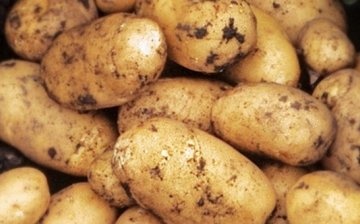
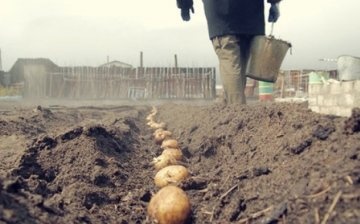
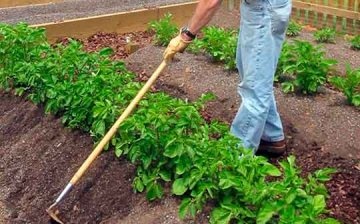







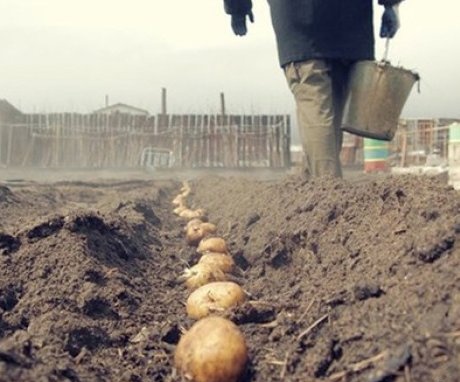

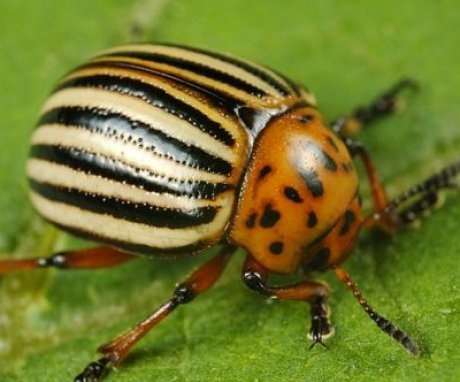
We planted Adretta several times, but, as indicated in the article, there has never been such a crop. True, they never put a clove of garlic in the hole and did not fertilize the potatoes with ash and superphosphate, but only compost was used.